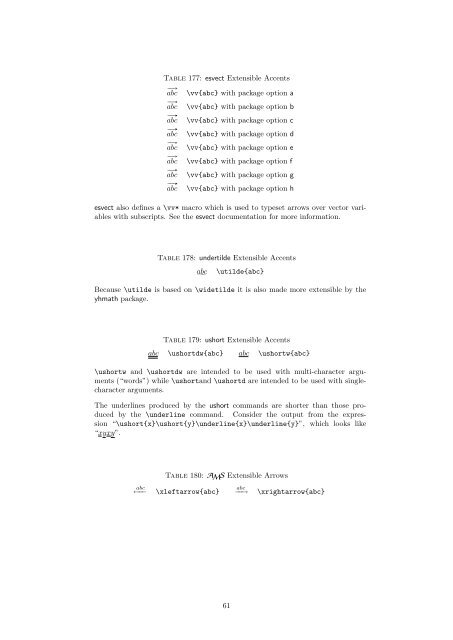symbols-a4
symbols-a4
symbols-a4
Create successful ePaper yourself
Turn your PDF publications into a flip-book with our unique Google optimized e-Paper software.
Table 177: esvect Extensible Accents<br />
# ”<br />
abc \vv{abc} with package option a<br />
# „<br />
abc \vv{abc} with package option b<br />
# «<br />
abc \vv{abc} with package option c<br />
# »<br />
abc \vv{abc} with package option d<br />
# –<br />
abc \vv{abc} with package option e<br />
# —<br />
abc \vv{abc} with package option f<br />
# <br />
abc \vv{abc} with package option g<br />
# ‰<br />
abc \vv{abc} with package option h<br />
esvect also defines a \vv* macro which is used to typeset arrows over vector variables<br />
with subscripts. See the esvect documentation for more information.<br />
Table 178: undertilde Extensible Accents<br />
abc \utilde{abc}<br />
›<br />
Because \utilde is based on \widetilde it is also made more extensible by the<br />
yhmath package.<br />
Table 179: ushort Extensible Accents<br />
abc \ushortdw{abc} abc \ushortw{abc}<br />
\ushortw and \ushortdw are intended to be used with multi-character arguments<br />
(“words”) while \ushortand \ushortd are intended to be used with singlecharacter<br />
arguments.<br />
The underlines produced by the ushort commands are shorter than those produced<br />
by the \underline command. Consider the output from the expression<br />
“\ushort{x}\ushort{y}\underline{x}\underline{y}”, which looks like<br />
“xyxy”.<br />
Table 180: AMS Extensible Arrows<br />
abc<br />
←−− \xleftarrow{abc}<br />
61<br />
abc<br />
−−→ \xrightarrow{abc}


